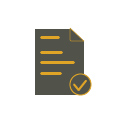Paycheck Protection Program loans or PPP loans are loans governed by the Small Business Administration (SBA) and administered through banks like us. All PPP loans have the same terms—a 1% interest rate and a 5-year term. If you use your PPP loan proceeds to fund certain items, like payroll, the entire loan can be forgiven.
Almost all businesses are eligible for PPP loans, including self-employed individuals and farmers. Non-profits and religious entities may also apply. Some special circumstances do exist, so we can help determine if you are eligible.
The application period is open now and extends through May 31, 2021.
Applications
If you have never applied for a PPP loan, then you will want to apply for a first draw PPP loan. If you are self-employed and file your tax return on a Form 1040 with a Schedule C, choose the Schedule C Filer application below. All other applicants should choose the regular application.
First Draw Regular PPP Loan Application
First Draw Schedule C Filer Loan Application
If you applied for and received a PPP loan, then you will need to complete an application for a second draw PPP loan. If you are self-employed and file your tax return on a Form 1040 with a Schedule C, choose the Schedule C Filer application below. All other applicants should choose the regular application.
Second Draw Regular Loan Application
Second Draw Schedule C Filer Loan Application
Other Forms
Kansas Certificate of Existence
Colorado Certificate of Existence
First Draw PPP Loans
Most businesses—including nonprofits, sole proprietorships, and self-employed individuals are eligible for a first draw PPP loan. To be eligible:
- Your business must have been in operation on February 15, 2020; and
- You either have employees and incur payroll costs, are a self-employed individual filing a Schedule C on your tax return and had a gross income greater than 0, or a farmer filing a Schedule F and had gross income greater than 0; and
- You did not previously receive a PPP loan.
First Draw PPP Loan Summary
| Maximum Loan Amount |
•2.5x average monthly payroll costs (capped at $100,000 annually per employee)
•Can choose to base on either 2019 or 2020 average monthly payroll costs
•For Schedule C filers: Line 7 Gross Income (capped at $100,000) ÷ 12 x 2.5
•For Schedule F filers: Line 9 Gross Income (capped at $100,000) ÷ 12 x 2.5
|
| Required Documentation |
•Proof business was in operation in or around Feb. 15, 2020
•Aggregate payroll record (shows exactly what each employee was compensated over the total year)
•Form 941s for 2019 or 2020 (for whichever year you base your loan amount on)
•State Quarterly Wage Unemployment Insurance Tax Reporting for 2019 or 2020 (for whichever year you base your loan amount on)
•Evidence of any retirement, employee group health, life, disability, vision, and dental contributions (if included in loan amount)
•For self-employed individuals or farmers, your Schedule C or F
•For partnerships, your Form 1065 tax return including K-1s
•Driver's License (if not a current customer)
•If not applying individually, a Certificate of Existence (if not a current customer)
|
| Forgiveness |
•You must spend at least 60% of the loan proceeds on payroll costs for the entire loan to be forgiven. (Self-employed and farmers, without employees, are automatically considered in compliance with this requirement.)
•The remaining 40% of loan proceeds can be used on any of these other eligible expenses:
•Mortgage interest payments
•Rent
•Utilities
•Covered operations expenditures
•Covered property damage costs
•Covered supplier costs
•Covered worker protection expenditures
|
Second Draw PPP Loans
The Second Draw PPP loans are targeted to those businesses, self-employed individuals and farmers that experienced a 25% reduction in revenue during 2020. Review the eligiblity requirements below:
- Your business must have been in operation on February 15, 2020; and
- You either have employees and incur payroll costs, are a self-employed individual filing a Schedule C on your tax return and had a gross income greater than 0, or a farmer filing a Schedule F and had gross income greater than 0; and
- Previously received a PPP loan (even if from a different lender); and
- Has used the full amount of your first PPP loan; and
- Experienced a gross revenue decline of at least 25%. More info on that here.
Second Draw PPP Loan Summary
| Maximum Loan Amount |
•2.5x (3.5x for NAICS code 72) average monthly payroll costs (capped at $100,000 annually per employee)
•Can choose to base on either 2019 or 2020 average monthly payroll costs
•Schedule C: Line 7 Gross Income (capped at $100,000) ÷ 12 x 2.5
•Schedule F: Line 9 Gross Income (capped at $100,000) ÷ 12 x 2.5 |
| Required Documentation |
•Proof of 25% revenue reduction (for loans <$150,000 can be obtained at time of forgiveness application) •Proof business was in operation on or around Feb. 15, 2020 •Aggregate payroll record (shows exactly what each employee was compensated over the total year) •Form 941s for 2019 or 2020 (whichever year you base your loan amount on) •State Quarterly Wage Unemployment Insurance Tax Reporting for 2019 or 2020 (whichever year you base your loan amount on) •Evidence of any retirement, employee group health, life, disability, vision, and dental contributions (if included in loan amount) •For self-employed individuals or farmers, your Schedule C or F •For partnerships, your Form 1065 tax return including K-1s •Driver's License (if not a current customer) •If not applying individually, a Certificate of Existence (if not a current customer)
|
| Forgivness |
•You must spend at least 60% of the loan proceeds on payroll costs for the entire loan to be forgiven. (Self-employed and farmers, without employees are automatically considered in compliance with this requirement.)
•The remaining 40% of loan proceeds can be used on any of these other eligible expenses:
•Mortgage interest payments
•Rent
•Utilities
•Covered operations expenditures
•Covered property damage costs
•Covered supplier costs
•Covered worker protection expenditures
|
Calculating Revenue Reduction
To be eligible for a Second Draw PPP loan, you must have experienced a revenue reduction (also referred to as gross receipt reduction) of 25% or greater in 2020 relative to 2019. To calculate this revenue reduction percentage, you should compare your quarterly gross receipts for one quarter in 2020 to the gross receipts of the corresponding quarter of 2019. For example, a borrower with gross receipts of $50,000 in the second quarter of 2019 and gross receipts of $30,000 in the second quarter of 2020 has experienced a revenue reduction of 40% between the quarters.
If your loan amount is less than $150,000, we will accept your attestation in lieu of any documentation of the 25% reduction. However, at the time you apply for forgiveness of the Second Draw PPP loan, the SBA will require you to provide the following information (only one set is required):
- Quarterly financial statements for the entity. If the financial statements are not audited, you must sign and date the first page of the financial statement and initial all other pages, attesting to their accuracy. If the financial statements do not specifically identify the line item(s) that constitute gross receipts, you must annotate which line item(s) constitute gross receipts.
- Quarterly or monthly bank statements for the entity showing deposits from the relevant quarters. You must annotate, if it is not clear, which deposits listed on the bank statement constitute gross receipts (e.g., payments for purchases of goods and services) and which do not (e.g., capital infusions).
- Annual IRS income tax filings of the entity. If the entity has not yet filed a tax return for 2020, you must fill out the return forms, compute the relevant gross receipts value, and sign and date the return, attesting that the values that enter into the gross receipts computation are the same values that will be filed on the entity’s tax return.







